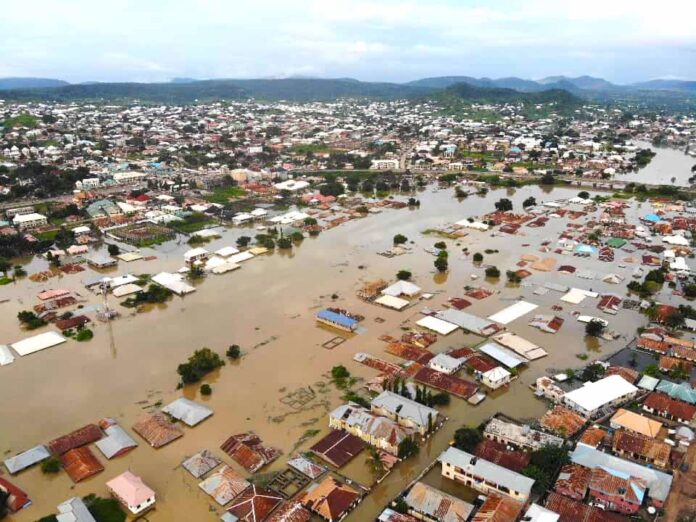The early morning calm of Lagos was shattered by a relentless torrential downpour, unleashing a wave of flash floods that brought Nigeria’s economic hub to a grinding halt. From the first drops, it was clear this was no ordinary rain. The deluge quickly overwhelmed the city’s drainage systems, transforming streets into rivers and leaving a trail of chaos that paralysed business and stranded countless residents.
A City Paralyzed by Water
The heavy rainfall had an immediate and devastating effect on daily life. Major arterial roads, typically buzzing with the morning commute, became impassable waterways. Motorists who had optimistically set out for work soon found themselves in a monumental traffic gridlock, their vehicles submerged and their journeys halted for hours. The familiar symphony of horns was replaced by the sound of rushing water and the frustrated murmurs of stranded commuters.
Areas across the metropolis reported severe flooding. In residential neighbourhoods, floodwaters surged into homes, damaging property and displacing families. Businesses, particularly those on ground floors, were forced to close as employees were either unable to reach their workplaces or had to contend with the rising water. The economic fallout was immediate, with a day’s worth of trade lost to the forces of nature.
The Warning That Went Unheeded
The chaos, while sudden, was not entirely without warning. The Nigerian Meteorological Agency (NiMet) had issued a comprehensive weather outlook just days before, predicting thundery and rainy activities across the nation. The agency’s Sunday forecast specifically highlighted a high possibility of flash floods, cautioning residents in several states, including Lagos, to be prepared.
According to NiMet’s bulletin, Monday morning was expected to bring moderate rains to parts of Adamawa, Taraba, Sokoto, Kebbi, Zamfara, Jigawa, Kano, and Katsina in the northern region. Simultaneously, the southern region was forecast to see cloudy skies with light rains over parts of Ebonyi, Enugu, Imo, Anambra, Abia, Ogun, Edo, Delta, Lagos, Rivers, Cross River, Akwa Ibom, and Bayelsa states.
The forecast for the latter part of the day was equally specific, predicting light rains over parts of Abia, Imo, Ebonyi, Anambra, Osun, Ogun, Oyo, Ondo, Ekiti, Edo, Delta, Bayelsa, Rivers, Lagos, Cross River, and Akwa Ibom States. Most significantly, NiMet had anticipated a high probability of floods occurring over parts of Oyo, Ogun, Edo, and Delta during the same period. While Lagos was specifically mentioned in the morning outlook, the sheer intensity of the downpour and its resulting impact took many by surprise, turning the agency’s caution into a harsh reality.
The Human Cost of the Deluge
Beyond the traffic and economic disruption, the floods exacted a heavy human toll. Residents described harrowing escapes from their homes as water levels rose at an alarming rate. For many, the day became a test of resilience, as they waded through dirty, waist-deep water to find a safe haven or to check on loved ones. The experience was particularly difficult for the most vulnerable members of the community, including the elderly and young children.
In a city known for its vibrant energy and fast-paced lifestyle, the floods served as a humbling reminder of nature’s power. It was a day of collective frustration, but also one that highlighted the spirit of community as neighbours helped one another, pushing stalled vehicles and offering shelter to those caught in the storm.
A Recurring Challenge and the Road Ahead
This latest episode of severe flooding brings to the forefront a recurring, and often devastating, challenge for Lagos. The city’s low-lying coastal geography, coupled with a rapidly growing population and often-strained infrastructure, makes it particularly vulnerable to heavy rains. Many residents and experts point to inadequate and poorly maintained drainage systems as a primary cause, arguing that existing infrastructure is no longer sufficient to handle the sheer volume of water.
As the floodwaters slowly recede and the city begins the clean-up, the conversation inevitably shifts to long-term solutions. While NiMet’s warnings provide a crucial first step in preparation, they cannot address the root causes of the problem. Effective urban planning, investment in modern and expansive drainage systems, and a concerted effort to enforce building codes that protect natural water paths are all critical components of a sustainable solution. Without these measures, Lagos remains susceptible to the next major downpour, and its residents will continue to live with the fear of another day crippled by water.


